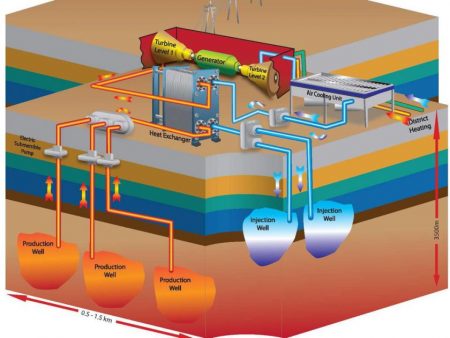May 19, 2018 – According to a 2016 World Energy Council Report, geothermal energy contributes less than 1% of the world’s electricity. As of 2015, total global capacity amounted to 13.2 gigawatts. The countries producing the most include China, Turkey, Iceland, Japan, Hungary, New Zealand and the United States.
How does geothermal energy work? The technology takes advantage of the Earth’s internal thermal properties by drilling deep into its crust and using that heat to convert water to steam to drive turbines attached to generators. It should, therefore, be no surprise, that most geothermal facilities are found in countries where there are volcanoes and hotspots that can be tapped into. Once tapped into, a geothermal resource can supply power for a century or longer before the hot spot dissipates.
What has held geothermal projects back? Higher installed costs and long development timelines compared to wind and solar are mentioned most often. But as utilities look to alternatives to coal-fired power in the face of climate change, the province of Saskatchewan is looking at developing a hot sedimentary aquifer located at a depth greater than 3,000 meters (approximately 10,000 feet) in an area known as the Williston Basin. The resource stretches more than 100 kilometers (60 miles), is 100 to 150 meters (330 to 500 feet) thick and measures temperatures in excess of 120 Celsius (approximately 250 Fahrenheit) degrees.
DEEP Earth Energy Production Corp., a Saskatoon-based company intends to tap this heat source and has signed an agreement with SaskPower, the province’s major energy utility to build a number of 10 to 30-megawatt facilities to achieve 200 megawatts in total capacity. For the province, the development of geothermal along with other renewable sources will help it achieve a 50% green energy goal by 2030. Currently, the province relies heavily on coal and natural gas for the bulk of its electricity. And although SaskPower’s Boundary Dam Project is the first carbon sequestration facility in Canada, the province continues to be a significant carbon emitter.
DEEP’s new plant will be located near Estevan, just north of the U.S. border. The initial test facility uses an Organic Rankine Cycle technology where water when injected underground returns as water-steam to the surface where it interacts through a heat exchanger with a second fluid with a lower boiling point. The steam from the second fluid is then used to drive a turbine connected to a generator producing up to 5 megawatts of electricity continuously.
The Canadian Geothermal Energy Association (CanGEA) released a report back in 2011 indicating that 40% of the country’s landmass had geothermal potential. It indicated that remote northern communities could benefit from geothermal power and suggested 100 project sites where small plants could be built. Having said that, surprisingly, this DEEP facility will be the first of its kind in the country. Let’s hope that its success leads to many others being built. CanGEA believes that Canada’s geothermal capacity could replace up to 10% of the country’s current power generating facilities, equal to 10 nuclear power plants.








